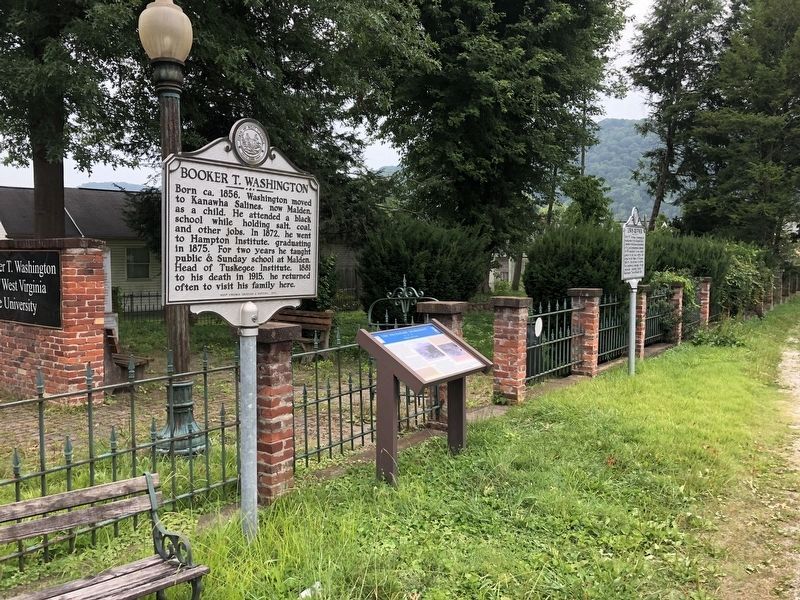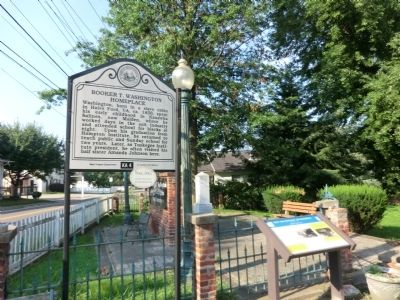Malden in Kanawha County, West Virginia — The American South (Appalachia)
The Necessary Ingredient
Malden's Salt Works
In the decades before the Civil War, this region, called the Kanawha Salines, had a booming salt industry. Salt extraction created vast wealth here, and by 1846, this area had led the nation with 3.2 million bushels produced. During the Civil War, salt was a necessary ingredient for the preservation of meat for the armies. The salt works here at Malden were especially important to the Confederacy.
Salt businesses relied on slaves, owned or leased, and the workers face difficult conditions. Many jobs were dangerous…mining the coal to boil the brine was especially so. Slaves toiled at the 52 furnaces that lined the Kanawha River for ten miles above Charleston. By 1850, 3,140 slaves lived among the 12,001 white inhabitants, and more than half of the slaves worked in the salt operations.
Many salt-works owners lived here in Malden, while others built large estates along the Kanawha River in Charleston to escape the heat and pollution of the furnaces. Several of the houses still stand on Kanawha Boulevard. By 1861, the salt industry here was in decline because of the development of salt fields farther west, as well as the westward shift of the meatpacking industry. The Civil War and a record flood on the Kanawha River hastened its collapse.
[Sidebars:]
In 1853, saltmaker Richard Lovell estimated the employment of hands at his two salt furnaces as: 14 coal diggers; 5 wheelers [moved coal to mine mouth]; 4 haulers [moved coal by team on rail tramway to furnace]; 3 kettle tenders [boiled brine to recover salt]; 1 or 2 cat hole [coal ash repository] cleaners; 6 engineers [ran steam engines to pump brine from well]; 2 salt lifters and wheelers [moved salt to packing shed]; 7 "jim arounds" and packers [general laborers, firemen packed salt into barrels]; 2 blacksmiths; 1 "negro man sort of manager."
Born into slavery on a Virginia farm, nine-year old Booker T. Washington moved to Malden with his family in 1865 after the war ended. He packed salt, mined coal, and worked for the wealthy Ruffner family. His labors spurred his thirst for an education. Washington became a prominent educator and leading spokesman for African Americans from 1895 until his death in 1915. Booker returned here often to visit his sister, Amanda Johnson. The nearby site of her brick house is now West Virginia State University Park.
Erected by West Virginia Civil War Trails.
Topics and series. This historical marker is listed in these topic lists: African Americans • War, US Civil. In addition, it is included in the Historically Black Colleges and Universities
Location. 38° 17.931′ N, 81° 33.462′ W. Marker is in Malden, West Virginia, in Kanawha County. Marker is at the intersection of Malden Drive (County Route 60/6) and Cypress Drive, on the right when traveling south on Malden Drive. Touch for map. Marker is at or near this postal address: 4200 Malden Drive, Charleston WV 25306, United States of America. Touch for directions.
Other nearby markers. At least 8 other markers are within 3 miles of this marker, measured as the crow flies. Booker T. Washington (here, next to this marker); Lewis Ruffner (here, next to this marker); a different marker also named Booker T. Washington (here, next to this marker); African Zion Baptist Church (about 300 feet away, measured in a direct line); Rev. Ruffner's Grave (about 800 feet away); Ruffner Well (approx. ¼ mile away); Burning Spring Monument (approx. 2 miles away); Daniel Boone (approx. 2.6 miles away). Touch for a list and map of all markers in Malden.
Credits. This page was last revised on August 5, 2021. It was originally submitted on September 3, 2012, by Don Morfe of Baltimore, Maryland. This page has been viewed 678 times since then and 10 times this year. Photos: 1. submitted on September 3, 2012, by Don Morfe of Baltimore, Maryland. 2. submitted on August 5, 2021, by Devry Becker Jones of Washington, District of Columbia. 3. submitted on September 3, 2012, by Don Morfe of Baltimore, Maryland. • Craig Swain was the editor who published this page.


